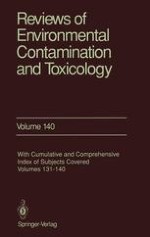Reviews of Environmental Contamination and Toxicology provides detailed review articles concerned with aspects of chemical contaminants, including pesticides, in the total environment with toxicological considerations and consequences. L.S. ANDREWS, M. AHMEDNA, R.M. GRODNER, J.A. LIUZZO, P.S. MURANO, E.A. MURANO, R.M. RAI, S. SHANE, AND P.W. WILSON: Food Preservation Using Ionizing Radiation CARMEN CABRERA, EDUARDO ORTEGA, MARIA-LUISA LORENZO, AND MARIA-DEL- CARMEN LOPEZ: Cadmium Contamination of Vegetable Crops, Farmlands and Irrigation Waters N.M. VAN STRAALEN AND J.P. VAN RIJN: Ecotoxicological Risk Assessment of Soil Fauna Recovery from Pesticide Application
